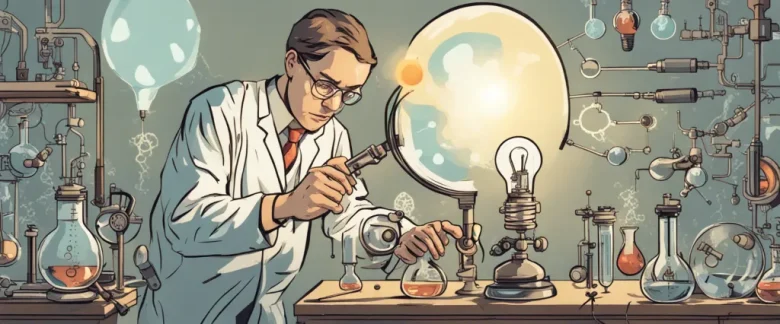In his acclaimed work, What Is This Thing Called Science, Alan Chalmers invites readers on an enlightening journey to explore the fundamental nature of science. Released in 1976, this seminal book continues to be highly regarded for its insights into the philosophy of science. Chalmers, an esteemed philosopher and science historian, delves deep into the complexities of the scientific enterprise, aiming to unravel the distinctive methods, theories, and controversies that underpin its practice. By critically examining the nature of scientific knowledge, Chalmers challenges conventional notions of objectivity and explores the interplay between theory and observation. Through his engaging analysis, Chalmers offers a thought-provoking exploration that will appeal to both experts and enthusiasts in the scientific realm.
Chapter 1: Introduction to the Philosophy of Science
Chapter 1 of the book “What Is This Thing Called Science” by Alan Chalmers serves as an introduction to the philosophy of science. Chalmers aims to explore the foundational concepts and principles behind scientific methodology and investigate the nature of scientific knowledge.
The chapter begins by highlighting the widespread acceptance and influence of science in our modern society while acknowledging the ambiguous and multifaceted nature of the term “science.” Chalmers explains that science is not limited to a single method or a fixed set of practices but encompasses various branches, each with its own unique approach.
He then introduces the concept of scientific knowledge as an attempt to understand the world through observation and experimentation. Chalmers emphasizes the importance of empirical evidence in science and the role of induction in acquiring knowledge. However, he acknowledges the limitations of induction, which can only provide probable rather than absolute certainty.
The author also discusses the role of theory in science, highlighting its crucial function in organizing and explaining empirical data. He introduces the concept of a scientific hypothesis as a proposed explanation for observed phenomena. Chalmers emphasizes that scientific theories are never conclusively proven but are instead supported by empirical evidence and capable of being falsified.
Furthermore, Chalmers outlines some common misconceptions about science, such as the idea that science only deals with indisputable facts or that it is a purely objective discipline. He argues that science is a human endeavor influenced by various social, cultural, and historical factors, which can introduce biases and subjectivity.
In summary, Chapter 1 provides a broad overview of the philosophy of science, introducing the concept of scientific knowledge, the role of empirical evidence, the importance of theories, and the limitations and social aspects of science. It sets the stage for a deeper exploration of the nature of scientific inquiry and the methods employed in subsequent chapters.
Chapter 2: The Scientific Method
Chapter 2 of “What Is This Thing Called Science” by Alan Chalmers introduces and explores the scientific method as a fundamental tool in scientific inquiry. Chalmers begins by acknowledging that scientific knowledge is different from other forms of knowledge because it is based on empirical evidence and subject to revisability. He argues that the scientific method is an active process involving the generation and testing of hypotheses.
Chalmers describes the scientific method as a cyclical process consisting of several interconnected stages. The initial stage is observation, where scientists gather data and facts from the natural world. From these observations, scientists then formulate a hypothesis, which is an educated guess or proposed explanation for the observed phenomena.
The next stage involves the testing of the hypothesis through experimentation. Chalmers emphasizes the importance of controlled experiments, where scientists manipulate and control variables to isolate the effects of specific factors. By doing so, scientists can determine whether their hypothesis accurately predicts the observed outcomes.
If the hypothesis is supported by the experimental results, it can be refined and further tested. Chalmers highlights the necessity of replication, as multiple experiments should consistently reproduce the same results. If the hypothesis fails to align with the data, it may be modified, rejected, or new hypotheses may be formulated.
Chalmers also discusses the role of theory in the scientific method. A scientific theory is a comprehensive explanation that provides a framework for understanding a wide range of phenomena. Theories are constructed based on substantial evidence and can be used to make predictions about future observations.
In summary, Chalmers presents the scientific method as a systematic process involving observation, hypothesis formulation, experimentation, and theory building. He emphasizes the importance of empirical evidence, testing, and revising hypotheses to ensure the reliability and progress of scientific knowledge.
Chapter 3: Induction and Confirmation
Chapter 3 of the book “What Is This Thing Called Science” by Alan Chalmers discusses the concepts of induction and confirmation in scientific methodology. Induction involves making generalizations based on specific observations or instances, while confirmation refers to the process of verifying or strengthening these generalizations through more experimentation and testing.
Chalmers starts by explaining that induction plays a crucial role in scientific reasoning. It involves reasoning from particular cases to formulate general principles or laws. However, he highlights that induction is inherently limited and can never guarantee absolute certainty. Scientific knowledge is always provisional and subject to revision based on further evidence.
The chapter further explores the problem of induction, as coined by philosopher David Hume. Hume argued that induction is unjustifiable as there is no logical basis to assume that the future will resemble the past. Chalmers acknowledges this challenge and emphasizes that scientific induction involves making an inference to the best explanation based on evidence and foreground theories.
Confirmation, on the other hand, involves subjecting scientific hypotheses or claims to rigorous testing and experimentation. Chalmers introduces the concept of falsification, first proposed by philosopher Karl Popper, which asserts that science progresses by formulating and testing hypotheses that can be disproven. Scientific claims gain more confirmation when they survive repeated attempts to falsify them.
Furthermore, Chalmers explores the Bayesian approach to confirmation theory, which assigns probabilities to scientific claims based on prior knowledge and the accumulation of evidence. This probabilistic perspective acknowledges that scientific knowledge is always open to revision and that confirmation is a gradual and ongoing process.
Overall, Chapter 3 provides an overview of the role of induction and confirmation in scientific methodology, highlighting their strengths and limitations. It emphasizes the provisional nature of scientific knowledge and the continuous refinement of hypotheses through rigorous testing and falsification.
Chapter 4: Falsification and Popper’s Philosophy

Chapter 4 of the book “What Is This Thing Called Science” by Alan Chalmers focuses on the concept of falsification and Karl Popper’s philosophy of science. Popper argued that scientific theories should not be confirmed but rather subjected to rigorous attempts at falsification.
Popper criticized the traditional view that scientific theories can be proven true through the accumulation of supportive evidence. According to him, the problem with this approach is that it results in unfalsifiable theories, which are not scientific. Instead, Popper proposed that scientists should actively try to falsify their theories through experiments and observations. If a theory passes numerous falsification attempts, it gains reliability but never certainty. This means that scientific knowledge is always provisional and subject to revision.
The chapter also highlights Popper’s philosophy of demarcation, which seeks to distinguish scientific theories from non-scientific ones. He argued that a theory is genuinely scientific if it is falsifiable, meaning it is possible to conceive of an observation or experiment that could potentially contradict it. In contrast, theories that are not falsifiable, such as Freudian psychoanalysis or Marxism, are considered pseudo-scientific.
Chalmers further discusses the importance of open-mindedness and critical scrutiny in scientific research. Popper emphasized that scientists should actively seek out potential falsifications and challenges to their theories, rather than defensively protecting them. This approach promotes scientific progress by continuously refining and modifying theories based on empirical evidence.
In summary, Chapter 4 explores Karl Popper’s influential perspective on falsification in science. It critiques the idea of confirming theories and highlights the importance of actively attempting to refute them. Popper’s philosophy of science advocates for the demarcation between scientific and non-scientific theories based on falsifiability. It also emphasizes the significance of critical thinking and openness to improvement in scientific research.
Chapter 5: Theories and Models
Chapter 5 of “What Is This Thing Called Science” by Alan Chalmers focuses on the exploration of theories and models in science. Chalmers begins by discussing the crucial role of theories in scientific practice, as they provide explanations, predictions, and a framework for understanding the natural world.
The chapter expands on the concept of theories, outlining several different philosophical perspectives. The logical positivist conception suggests that theories should be reducible to observational statements, allowing for direct empirical testing. However, Chalmers argues that this view is overly restrictive and does not accurately reflect the complexity of scientific theories.
Chalmers introduces Thomas Kuhn’s work, highlighting one of the key aspects of his theory – the concept of a scientific paradigm shift. According to Kuhn, science progresses through periods of normal science, where researchers work within an established paradigm, and occasional scientific revolutions, where new frameworks emerge, often challenging the existing scientific dogma.
Chalmers then delves into the concept of a model, which he describes as a simplified representation of a real-world system. He discusses how models are used in scientific research to gain insight into complex phenomena and make predictions. Additionally, he emphasizes the importance of model selection, as different models may offer different levels of accuracy and applicability.
The chapter concludes by exploring the relationship between theories and models. Chalmers argues that theories and models are intimately connected, as theories serve as the foundation for constructing models. Models, in turn, help scientists analyze and manipulate the theoretical constructs, providing a deeper understanding of the phenomena under investigation.
In summary, Chapter 5 of “What Is This Thing Called Science” delves into the role of theories and models in scientific practice. The chapter explores various philosophical perspectives on theories, introduces Thomas Kuhn’s notion of paradigm shifts, explains the concept of models, and highlights the interconnectedness of theories and models in advancing scientific knowledge.
Chapter 6: Scientific Realism and Anti-Realism
Chapter 6 of “What Is This Thing Called Science” by Alan Chalmers explores the philosophical debate between scientific realism and anti-realism. The chapter begins by introducing scientific realism, which posits that scientific theories aim to provide an accurate representation of the world and that scientific entities, such as atoms or molecules, exist independently of our observations. Realists argue that scientific theories are successful because they correspond to the way the world actually is.
Chalmers presents several key arguments for scientific realism. Firstly, he discusses the success of science in making accurate predictions and technological advancements, suggesting a strong connection between scientific theories and reality. Secondly, he examines the concept of inference to the best explanation, which states that the best explanations are those that posit the existence of theoretical entities, providing additional evidence for realism. Moreover, Chalmers highlights the importance of instrumentalism in scientific practice, affirming that scientists rely on the assumption that their theories represent reality.
However, Chalmers also explores the counterarguments presented by anti-realists, who hold that scientific theories are mere instruments for making predictions and manipulating the world, without necessarily providing a true representation of reality. Anti-realists argue that scientific theories are continually subject to modification, revision, and even replacement, making it problematic to claim that they accurately depict the world.
Chalmers concludes the chapter by summarizing the debate between scientific realism and anti-realism, acknowledging the complexities involved and emphasizing that both positions contribute to our understanding of science. He suggests that the choice between the two perspectives ultimately depends on personal preference, as they both provide different justifications and interpretations regarding the nature of scientific knowledge.
Chapter 7: Social and Historical Dimensions of Science
Chapter 7 of the book “What Is This Thing Called Science” by Alan Chalmers explores the social and historical dimensions of science. Chalmers argues that science cannot be understood solely by examining its logical and empirical aspects but must also take into account the broader social and historical factors that influence its development and practice.
Chalmers begins by discussing the role of scientific communities in the advancement of knowledge. He asserts that scientific communities play a vital role in shaping what is considered as valid scientific knowledge, as they establish the norms and criteria for scientific inquiry. These communities are influenced by a variety of social factors such as power relations, funding sources, and political and cultural contexts.
The author then delves into the historical context of science, emphasizing that scientific theories and concepts are not fixed or absolute, but rather subject to change over time. He presents examples such as the shift from Ptolemaic astronomy to Copernican heliocentrism and the acceptance of Einstein’s theory of relativity, indicating that scientific revolutions often involve a paradigm shift in the underlying assumptions and methodologies of science.
Chalmers also highlights the influence of individual scientists on the development of scientific knowledge. He argues that scientists are not purely objective observers but are influenced by personal beliefs, biases, and societal pressures. He introduces the concept of “theory-ladenness,” which suggests that observations are interpreted in light of pre-existing theories and that scientists are often committed to defending their theories rather than objectively evaluating evidence.
In conclusion, Chapter 7 of “What Is This Thing Called Science” underscores the importance of understanding the social and historical dimensions of science in order to grasp its nature and limitations. By recognizing the impact of scientific communities, historical context, and individual scientists on the construction of knowledge, one can gain a more comprehensive and nuanced understanding of the scientific enterprise.

Chapter 8: The Limits of Science
Chapter 8 of “What Is This Thing Called Science” by Alan Chalmers explores the limitations of science. The chapter begins by emphasizing that while science is an incredibly powerful tool for understanding the natural world, it has its boundaries.
Chalmers discusses two main limitations of science. The first limitation revolves around the problem of induction. Induction is the process of drawing general conclusions from specific observations. However, Chalmers argues that induction can never provide absolute certainty. Scientific theories are always subject to revision or even abandonment as new evidence arises. This means that even the most successful scientific theories can never be proven beyond any doubt.
The second limitation Chalmers identifies is the issue of underdetermination. Underdetermination occurs when there are multiple competing theories that can explain the available evidence equally well. Chalmers argues that scientists often rely on background assumptions and values when choosing between these theories. These subjective factors can influence scientific decision-making and introduce an element of subjectivity into the process.
Additionally, Chalmers explores the problem of theory change, which highlights the fact that scientific knowledge is not static, but evolves over time. As new data and theories emerge, older theories may be replaced or modified. This continuous evolution means that scientific knowledge is always provisional and subject to change.
Overall, Chalmers concludes that while science is an invaluable tool that has revolutionized our understanding of the natural world, it is important to recognize its limits. Inductive reasoning, underdetermination, and the fluid nature of scientific knowledge all contribute to the acknowledgment that science can never provide final or absolute answers.
After Reading
In conclusion, “What Is This Thing Called Science” by Alan Chalmers provides a comprehensive overview of the philosophy of science. Chalmers highlights the complex and often misunderstood nature of scientific knowledge, challenging conventional views of objectivity and the scientific method. By examining historical examples and analyzing various theories, Chalmers encourages readers to critically reflect on the nature of science and the role it plays in society. Overall, the book offers a thought-provoking read that contributes to the ongoing dialogue surrounding the foundations and limitations of scientific inquiry.
1. The Structure of Scientific Revolutions” by Thomas S. Kuhn – This seminal work explores how scientific knowledge advances through paradigm shifts, challenging the notion of objective truth in science.
2. “Critical Thinking: A Concise Guide” by Tracy Bowell and Gary Kemp – This book provides a comprehensive introduction to critical thinking skills, including the evaluation of scientific claims and analytical reasoning.
3. The Demon-Haunted World: Science as a Candle in the Dark” by Carl Sagan – Sagan advocates for scientific skepticism and the use of critical thinking to combat pseudoscience, superstitions, and unfounded beliefs.
4. “Science: The Very Idea” by Steve Woolgar – Similar to Chalmers’ work, Woolgar delves into the philosophy of science, analyzing the social context and historical development of scientific knowledge.
5. “The Philosophy of Science: A Very Short Introduction” by Samir Okasha – This concise introduction outlines key concepts and debates within the philosophy of science, providing a foundation for understanding the nature of scientific inquiry.




